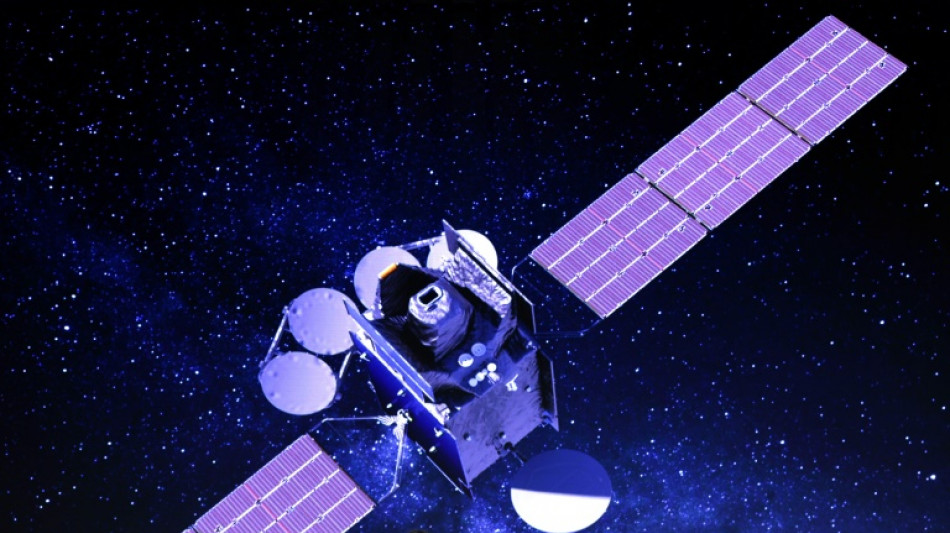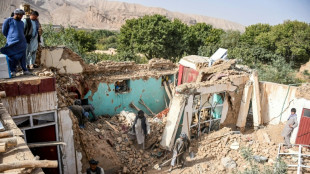
-
 Barrett brothers out of All Blacks' clash with Scotland
Barrett brothers out of All Blacks' clash with Scotland
-
Medieval tower partially collapses in Rome, trapping worker

-
 Arsenal's Arteta says injured Gyokeres out of Slavia Prague tie
Arsenal's Arteta says injured Gyokeres out of Slavia Prague tie
-
Alonso says 'quality' Wirtz helped get him Real Madrid job

-
 US Fed's Cook warns inflation to stay 'elevated' next year
US Fed's Cook warns inflation to stay 'elevated' next year
-
Blue heaven: huge crowds salute Los Angeles Dodgers in victory parade

-
 Dutch centrist Jetten clinches election win: final tally
Dutch centrist Jetten clinches election win: final tally
-
Mamdani extends olive branch to anxious NY business community

-
 Sierra Leone chimpanzee sanctuary reopens after deforestation protest
Sierra Leone chimpanzee sanctuary reopens after deforestation protest
-
Shein bans sex dolls after France outrage over 'childlike' ones

-
 England full-back Steward doubtful for Autumn rugby clash with Fiji
England full-back Steward doubtful for Autumn rugby clash with Fiji
-
Bayern know how to 'hurt' PSG, says Neuer

-
 Rybakina downs Swiatek to reach WTA Finals last four
Rybakina downs Swiatek to reach WTA Finals last four
-
Ex-France international Ben Yedder to stand trial on rape charges

-
 Djokovic confirmed for ATP Finals, says Italian federation boss
Djokovic confirmed for ATP Finals, says Italian federation boss
-
Trent should be remembered for 'great' Liverpool moments, says Slot

-
 Stock markets diverge despite boost from AI deals
Stock markets diverge despite boost from AI deals
-
Prince William awed by Rio on climate-focused trip to Brazil

-
 Violence in Sudan's El-Fasher could be war crimes, says top court
Violence in Sudan's El-Fasher could be war crimes, says top court
-
Rybakina downs Swiatek in WTA Finals

-
 Turkey, Muslim allies say Palestinian self-rule key to Gaza future
Turkey, Muslim allies say Palestinian self-rule key to Gaza future
-
Tens of thousands shelter as typhoon slams into Philippines

-
 Stock markets rise as tech sector buoyed by fresh AI deal
Stock markets rise as tech sector buoyed by fresh AI deal
-
Vitinha says PSG-Bayern Champions League clash will show who's 'best'

-
 Arsenal: The unstoppable Premier League force?
Arsenal: The unstoppable Premier League force?
-
Denmark inaugurates rare low-carbon hydrogen plant

-
 Springboks back Ntlabakanye call-up despite doping probe
Springboks back Ntlabakanye call-up despite doping probe
-
German plans to lower industrial power costs from January

-
 Christian, Muslim Nigerians push back on threatened US strikes
Christian, Muslim Nigerians push back on threatened US strikes
-
Nigeria's Rivers United paired with African champions Pyramids

-
 India women cricketers hail new era but challenges remain
India women cricketers hail new era but challenges remain
-
'Heroic' worker praised as man charged over UK train stabbings

-
 Bangladesh ex-PM Zia to contest elections: party
Bangladesh ex-PM Zia to contest elections: party
-
Tanzania president sworn in as opposition says hundreds killed in protests

-
 India announces $5.75 million reward for women cricket World Cup winners
India announces $5.75 million reward for women cricket World Cup winners
-
Spain regional leader resigns, a year after deadly floods

-
 Video game creators fear AI could grab the controller
Video game creators fear AI could grab the controller
-
France threatens Shein ban if 'childlike' sex dolls reappear

-
 International cricket returns to Faisalabad with Pakistan-South Africa ODIs
International cricket returns to Faisalabad with Pakistan-South Africa ODIs
-
Afghan govt says quake kills 20, injures over 500

-
 'We're all too rich,' says photo legend Martin Parr
'We're all too rich,' says photo legend Martin Parr
-
Tanzania president inaugurated as opposition says hundreds dead

-
 Shafali Verma: India's World Cup hero who disguised herself as boy
Shafali Verma: India's World Cup hero who disguised herself as boy
-
Most equity markets rise on lingering trader optimism

-
 Afghanistan quake kills 20, injures over 300: health ministry
Afghanistan quake kills 20, injures over 300: health ministry
-
India hails maiden women's World Cup cricket title as game-changer

-
 As clock ticks down, Greece tries to clean up its act on waste
As clock ticks down, Greece tries to clean up its act on waste
-
Local fabrics, fibres shine at eco-centred Lagos Fashion Week

-
 Spalletti bidding to revive Juve and reputation ahead of Sporting visit in Champions League
Spalletti bidding to revive Juve and reputation ahead of Sporting visit in Champions League
-
Tanzania president to be inaugurated as opposition says hundreds dead

| RBGPF | -3.95% | 76 | $ | |
| CMSD | -0.38% | 23.9 | $ | |
| NGG | -0.68% | 74.74 | $ | |
| CMSC | -0.34% | 23.67 | $ | |
| SCS | -0.76% | 15.84 | $ | |
| GSK | -1.1% | 46.35 | $ | |
| BTI | 2.38% | 52.44 | $ | |
| AZN | -0.83% | 81.72 | $ | |
| RIO | -1.95% | 70.37 | $ | |
| RELX | -0.16% | 44.17 | $ | |
| BCC | -3.15% | 68.34 | $ | |
| JRI | -0.14% | 13.88 | $ | |
| VOD | -5.89% | 11.38 | $ | |
| BP | -0.75% | 34.87 | $ | |
| BCE | -0.84% | 22.67 | $ | |
| RYCEF | 1.37% | 15.36 | $ |

Space-based NASA instrument to track pollution over North America
A Falcon 9 rocket successfully blasted off from Florida into space on Friday carrying a new NASA device that can track air pollution over North America down to the neighborhood level.
The launch, which took place at 12:30 am (0430 GMT), will bring into orbit the Tropospheric Emissions Monitoring of Pollution (TEMPO) instrument, which will allow scientists to monitor air pollutants and their emission sources more extensively than ever before.
The data will be used by the US Environmental Protection Agency, the National Oceanic and Atmospheric Administration and other agencies responsible for tackling atmospheric pollution.
"TEMPO will be measuring pollution and air quality across greater North America on an hourly basis during the daytime, all the way from Puerto Rico up to the tar sands of Canada," said Kevin Daugherty, NASA's TEMPO project manager.
A unique feature of TEMPO, which is about the size of a washing machine and has been described as a chemistry laboratory in space, is that it will be hosted on an Intelsat communications satellite in geostationary orbit.
"Geostationary orbit is a common orbit for weather satellites and communications satellites, but an air quality instrument measuring gases hadn't been there yet," said Caroline Nowlan, an atmospheric physicist at the Harvard & Smithsonian Center for Astrophysics.
Existing pollution-monitoring satellites are in low Earth orbit, which means they can only provide observations once a day at a fixed time.
"We can get measurements, say, over New York City at 1:30 in the afternoon," Nowlan said. "But that's just one data point over New York City over a day.
"The great thing about TEMPO is that for the first time we'll be able to make hourly measurements over North America, so we'll be able to see what's happening over a whole day as long as the sun is up."
In geostationary orbit 22,236 miles (35,786 kilometers) above the equator, TEMPO will match the rotation of the Earth, meaning it will stay over the same location -- North America -- at all times.
TEMPO will be able to measure atmospheric pollution down to a spatial resolution of four square miles (10 square kilometers), or neighborhood level.
Daugherty said TEMPO will power up at the end of May or in early June and begin producing data in October, although it will not be made available to the public until April of next year.
- Multiple applications -
TEMPO will have multiple applications from measuring levels of various pollutants to providing air quality forecasts and helping the development of emission-control strategies.
More than 40 percent of the US population, 137 million people, live in places with unhealthy levels of particle pollution or ozone, according to the American Lung Association, and air pollution is blamed for some 60,000 premature deaths a year.
Among the pollutants tracked by TEMPO will be nitrogen dioxide, produced from the combustion of fossil fuels, formaldehyde and ozone.
The data will be made available online for members of the public to monitor air quality information in their local area.
"Ozone up high is great. It protects us from ultraviolet radiation and allows life to exist on Earth," Nowlan said.
"But when ozone is at the surface, it's a pollutant and it's harmful to humans and also to crops and ecosystems."
TEMPO will also be able to track pollution caused by wildfires, which are becoming increasingly common and damaging as a result of climate change.
The TEMPO device, made by Ball Aerospace, is what is known as a spectrometer.
"It measures the sunlight that's reflected off the Earth's atmosphere and separates it into about 2,000 component wavelengths," said Dennis Nicks, director of payload engineering at Ball Aerospace.
The data is then used to determine the concentrations of trace gases in the atmosphere.
TEMPO will not be alone in its air quality monitoring mission in the Northern Hemisphere.
It will be part of a constellation that includes a South Korean device, GEMS, which has already been launched, and one under development by the European Space Agency, known as Sentinel-4.
J.Fankhauser--BTB



